Here is a selection of worthy backgammon books for players of every experience level. It is far from exhaustive. Where the author has identified a direct means of purchasing a book, we have linked the book image to it. Otherwise, we recommend trying Carol Joy Cole’s Backgammon a la Carte before resorting to Amazon or Google for the tougher-to-find titles.
Everyone
Backgammon (1976) - Paul Magriel
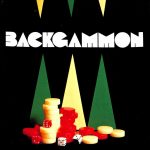 In a category all by itself, Paul Magriel’s Backgammon is often called “The backgammon bible.” It is the one indispensable book for all students of the game. Magriel was the first to thoroughly systematize the essential strategic game types (Running, Holding, Priming Attacking) and to articulate, with vivid clarity, many of the concepts (“Golden Point,” “Safe Play vs. Bold Play”) that form the vocabulary of modern backgammon analysis.
In a category all by itself, Paul Magriel’s Backgammon is often called “The backgammon bible.” It is the one indispensable book for all students of the game. Magriel was the first to thoroughly systematize the essential strategic game types (Running, Holding, Priming Attacking) and to articulate, with vivid clarity, many of the concepts (“Golden Point,” “Safe Play vs. Bold Play”) that form the vocabulary of modern backgammon analysis.
Novices with a determined, studious bent will find Magriel an excellent starting place, but the sheer bulk of the tome may intimidate or overwhelm many beginners.
Pictured here is the iconic 1976 hardcover edition. The book has been re-issued in a 2004 soft-cover edition, with a new forward by Renee Magriel Roberts, who is also now credited as co-author.
Beginner
Backgammon in 10 Minutes (2013) - Brian Byfield & Gray Joliffe
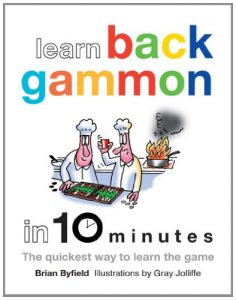 Here’s a perfect book for introducing a friend or family member, young or old, to the game of backgammon. This book covers everything they will need to know to get playing, and presents the basics by means of simple diagrams paired enlivened by delightful cartoon drawings by popular illustrator Gray Joliffe. The book also introduces basic concepts like priming and duplication, and even explains the Jacoby Rule and beavering in its brief treatment of the doubling cube. For the vast majority of people out there who aren’t already gaming aficionados, this is the gentlest, most inviting intro you could ask for.
Here’s a perfect book for introducing a friend or family member, young or old, to the game of backgammon. This book covers everything they will need to know to get playing, and presents the basics by means of simple diagrams paired enlivened by delightful cartoon drawings by popular illustrator Gray Joliffe. The book also introduces basic concepts like priming and duplication, and even explains the Jacoby Rule and beavering in its brief treatment of the doubling cube. For the vast majority of people out there who aren’t already gaming aficionados, this is the gentlest, most inviting intro you could ask for.
The Backgammon Book (1970) - Oswald Jacoby & John R. Crawford
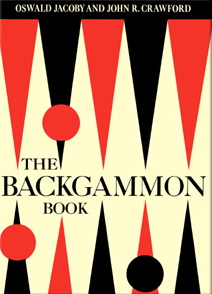 Although backgammon knowledge and practice have come a long, long way since 1970, The Backgammon Book remains one of the most effective introductions to competitive backgammon: fundamentals of dice probability, pip-counting, the “25% rule” for accepting doubles, and the concept of fair-settlement “equity” value inherent in a position are all here. Employing these kinds of tools is perhaps the defining difference between the novice and intermediate player. In addition to the usual coverage of tactics and strategy, Jacoby and Crawford provide an interesting chapter, full of pictures, of the game’s ancient — and modern — history, as well as chapters devoted to the social aspects of the game: general etiquette, chouette practices (now largely outdated), tournament practices, and popular rule variations. As this introductory text doesn’t delve too deep into the complexities of the game, only a very few positions have proven to be inaccurate by modern computer analysis (#’s 47, 55, 71, 77).
Although backgammon knowledge and practice have come a long, long way since 1970, The Backgammon Book remains one of the most effective introductions to competitive backgammon: fundamentals of dice probability, pip-counting, the “25% rule” for accepting doubles, and the concept of fair-settlement “equity” value inherent in a position are all here. Employing these kinds of tools is perhaps the defining difference between the novice and intermediate player. In addition to the usual coverage of tactics and strategy, Jacoby and Crawford provide an interesting chapter, full of pictures, of the game’s ancient — and modern — history, as well as chapters devoted to the social aspects of the game: general etiquette, chouette practices (now largely outdated), tournament practices, and popular rule variations. As this introductory text doesn’t delve too deep into the complexities of the game, only a very few positions have proven to be inaccurate by modern computer analysis (#’s 47, 55, 71, 77).
Backgammon For Winners (2002, 3rd Edition) - Bill Robertie
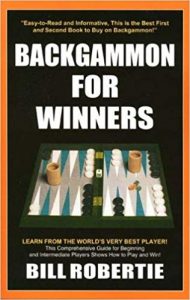 Bill Robertie is one of the few backgammon theorists who writes effectively for players at all level of experience, and this beginner’s book is probably the best practical introduction to the game of the modern era. Beyond all the requisite details of board set-up and rules, Robertie introduces essential strategies and tactics along with just enough in the way of probability and doubling theory to open up the excitement and subtlety of the game without overwhelming the novice reader. He also walks us through two complete sample games, revealing the excitement and intrigue available from backgammon, a teaching method oddly lacking from most beginner’s books.
Bill Robertie is one of the few backgammon theorists who writes effectively for players at all level of experience, and this beginner’s book is probably the best practical introduction to the game of the modern era. Beyond all the requisite details of board set-up and rules, Robertie introduces essential strategies and tactics along with just enough in the way of probability and doubling theory to open up the excitement and subtlety of the game without overwhelming the novice reader. He also walks us through two complete sample games, revealing the excitement and intrigue available from backgammon, a teaching method oddly lacking from most beginner’s books.
52 Great Backgammon Tips (2007) - Patti Beadles & Kit Woolsey
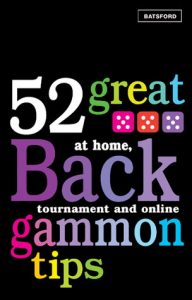 This is a terrifically fun primer that offers up pithy, memorable backgammon advice in 52 readily digestible servings. While the writing is light and engaging, the advice is rock-solid. Each chapter is vividly titled (“Learn to Count Shots,” “Rip Checkers Off,” “Double Volatile Positions”), making it a natural for browsing, but the material is presented in a careful sequence of increasing sophistication, so any player in the Beginner-Intermediate zone can skim over earlier, more obvious material if they like, and dig in when they discover new ideas. And even more experienced players can enjoy this book, if only to hear their intuitive perceptions of proper play made explicit.
This is a terrifically fun primer that offers up pithy, memorable backgammon advice in 52 readily digestible servings. While the writing is light and engaging, the advice is rock-solid. Each chapter is vividly titled (“Learn to Count Shots,” “Rip Checkers Off,” “Double Volatile Positions”), making it a natural for browsing, but the material is presented in a careful sequence of increasing sophistication, so any player in the Beginner-Intermediate zone can skim over earlier, more obvious material if they like, and dig in when they discover new ideas. And even more experienced players can enjoy this book, if only to hear their intuitive perceptions of proper play made explicit.
Backgammon To Win (2018, Revised) - Chris Bray
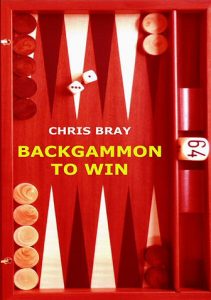 The popular “. . . for Dummies” instructional series tapped respected British backgammon author Chris Bray, to lay out the game in an appealing, accessible way for the beginning player, and this is Bray’s more traditional presentation of that material. This fine introductory text covers a broad range of topics germane to playing backgammon at tournaments, in local chouettes and “money games” as well as online, so this isn’t just a book about how to play the checkers and when to deploy the doubling cube: it’s a practical guide to entering the whole wide world of backgammon beyond your kitchen table.
The popular “. . . for Dummies” instructional series tapped respected British backgammon author Chris Bray, to lay out the game in an appealing, accessible way for the beginning player, and this is Bray’s more traditional presentation of that material. This fine introductory text covers a broad range of topics germane to playing backgammon at tournaments, in local chouettes and “money games” as well as online, so this isn’t just a book about how to play the checkers and when to deploy the doubling cube: it’s a practical guide to entering the whole wide world of backgammon beyond your kitchen table.
Intermediate
Backgammon For Profit (1975) - Joe Dwek
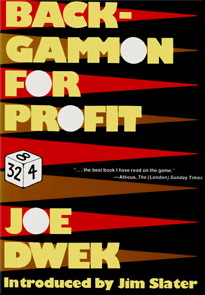 Backgammon For Profit, written around the same time as Magriel’s Backgammon, could almost be regarded as an accompanying quiz book, inviting students of the game to build upon the broad conceptual knowledge provided by Magriel with a variety of more finely-tuned checker and cube problems. While modern backgammon software has found a fair number of Dwek’s solutions to be in error, this book can still be studied to great advantage, particularly if you annotate it with corrections discussed in Jeremy Bagai’s Classic Backgammon Revisited (see below).
Backgammon For Profit, written around the same time as Magriel’s Backgammon, could almost be regarded as an accompanying quiz book, inviting students of the game to build upon the broad conceptual knowledge provided by Magriel with a variety of more finely-tuned checker and cube problems. While modern backgammon software has found a fair number of Dwek’s solutions to be in error, this book can still be studied to great advantage, particularly if you annotate it with corrections discussed in Jeremy Bagai’s Classic Backgammon Revisited (see below).
Advanced Backgammon Vols. 1 & 2 (1991) - Bill Robertie
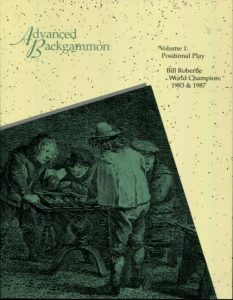
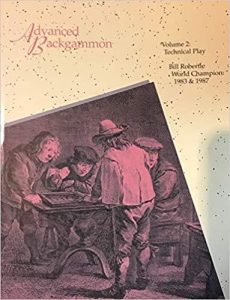 This two-volume set of problems is a very natural next step for solid intermediates who have absorbed the fundamental lessons in Magriel’s Backgammon. Originally published in a single volume in 1984, this thorough revision doubles the problem count to 400 and divides the material into separate volumes on “Positional” and “Technical” play. Students of the game will be introduced to several useful “reference positions” — highly specific scenarios that, once mastered, can guide play in situations you’re bound to encounter over and over again. (The emphasis on cube action is particularly valuable, given that Magriel gives scant attention to this crucial element of backgammon). As with all books written in the pre-bot era, some of the solutions have been found inaccurate, so it’s well worth annotating your copy with corrections to be found in Jeremy Bagai’s Classic Backgammon Revisited (see below).
This two-volume set of problems is a very natural next step for solid intermediates who have absorbed the fundamental lessons in Magriel’s Backgammon. Originally published in a single volume in 1984, this thorough revision doubles the problem count to 400 and divides the material into separate volumes on “Positional” and “Technical” play. Students of the game will be introduced to several useful “reference positions” — highly specific scenarios that, once mastered, can guide play in situations you’re bound to encounter over and over again. (The emphasis on cube action is particularly valuable, given that Magriel gives scant attention to this crucial element of backgammon). As with all books written in the pre-bot era, some of the solutions have been found inaccurate, so it’s well worth annotating your copy with corrections to be found in Jeremy Bagai’s Classic Backgammon Revisited (see below).
*3 "Matchquiz" books from Gammon Press (1994) - Kit Woolsey
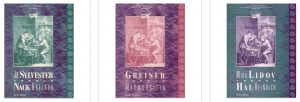 Bill Robertie will tell you that the era of match-analysis books is over — people just don’t buy ’em anymore. If so, that’s a shame. The more popular “problem books” make fewer demands on us as readers: you can read them on the toilet. But to improve in match play — to flourish in high-level tournament competition — more sustained attention is required. These three books by Kit Woolsey simulate the experience of playing out a match in real time with one of the best, most articulate players in the world at your elbow, coaching you through the thought processes of both players. What’s more, as a trio, they illustrate vividly different match-play scenarios: playing from behind (Greiner/Marmorstein), playing with a lead (Sylvester/Ballard), and pitting a ‘pure’ vs. ‘modern’ style of action (Lidov/Heinrich). What’s more, these texts are even more effective now than in 1994, because all three match transcriptions are available on BG Studio, where you can re-play them as one player and then all over again as the other! BG Studio will rate your moves and keep a running PR comparison between you and the original player. You should also download the match files, import them to XG, and temper Woolsey’s pre-bot analysis with state-of-the-art neural net evaluations — because backgammon has come a long way since 1994.
Bill Robertie will tell you that the era of match-analysis books is over — people just don’t buy ’em anymore. If so, that’s a shame. The more popular “problem books” make fewer demands on us as readers: you can read them on the toilet. But to improve in match play — to flourish in high-level tournament competition — more sustained attention is required. These three books by Kit Woolsey simulate the experience of playing out a match in real time with one of the best, most articulate players in the world at your elbow, coaching you through the thought processes of both players. What’s more, as a trio, they illustrate vividly different match-play scenarios: playing from behind (Greiner/Marmorstein), playing with a lead (Sylvester/Ballard), and pitting a ‘pure’ vs. ‘modern’ style of action (Lidov/Heinrich). What’s more, these texts are even more effective now than in 1994, because all three match transcriptions are available on BG Studio, where you can re-play them as one player and then all over again as the other! BG Studio will rate your moves and keep a running PR comparison between you and the original player. You should also download the match files, import them to XG, and temper Woolsey’s pre-bot analysis with state-of-the-art neural net evaluations — because backgammon has come a long way since 1994.
Understanding Backgammon (2003) - Kit Woolsey & Tami Jones
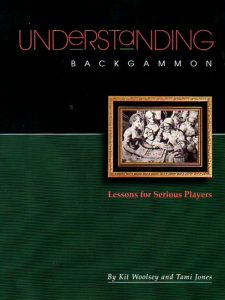 Where do backgammon writers get the positions for their books? Often, from their own high-quality matches, or by artificially setting them up to explore and validate sophisticated concepts. Understanding Backgammon will appeal to intermediate players because the problems are all genuine game positions that got the best of a genuine intermediate player, Tami Jones. The discussion of each problem comes in the form of a Socratic dialogue, with Kit Woolsey in the role of the philosopher bringing along his pupil — and the effect of hearing out the erroneous arguments in the course of arriving at the correct one is surprisingly effective, because we all need practice countering the bad arguments we form over the board. Woolsey is adept at making his arguments gently yet persuasively.
Where do backgammon writers get the positions for their books? Often, from their own high-quality matches, or by artificially setting them up to explore and validate sophisticated concepts. Understanding Backgammon will appeal to intermediate players because the problems are all genuine game positions that got the best of a genuine intermediate player, Tami Jones. The discussion of each problem comes in the form of a Socratic dialogue, with Kit Woolsey in the role of the philosopher bringing along his pupil — and the effect of hearing out the erroneous arguments in the course of arriving at the correct one is surprisingly effective, because we all need practice countering the bad arguments we form over the board. Woolsey is adept at making his arguments gently yet persuasively.
Backgammon Boot Camp (2004) - Walter Trice
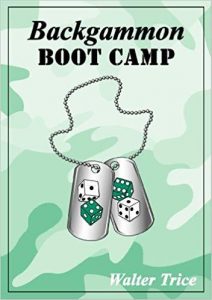 Backgammon Boot Camp started life as a series of articles Walter Trice wrote for the online backgammon magazine GammonVillage (still an excellent resource!). Walter’s series was called “Beginners’ Boot Camp,” and each of the articles (now chapters) presents a pithy, very practical tool, idea, or technique for making the right decisions in all phases of the game. Accomplished players too will find challenging and valuable new material here, particularly in the quantitative sophistication of Trice’s Effective Pipcount, a technique for evaluating racing efficiency that has been so widely embraced that ‘EPC’ is a metric displayed on eXtreme Gammon’s coaching screen, right next to the raw pip count.
Backgammon Boot Camp started life as a series of articles Walter Trice wrote for the online backgammon magazine GammonVillage (still an excellent resource!). Walter’s series was called “Beginners’ Boot Camp,” and each of the articles (now chapters) presents a pithy, very practical tool, idea, or technique for making the right decisions in all phases of the game. Accomplished players too will find challenging and valuable new material here, particularly in the quantitative sophistication of Trice’s Effective Pipcount, a technique for evaluating racing efficiency that has been so widely embraced that ‘EPC’ is a metric displayed on eXtreme Gammon’s coaching screen, right next to the raw pip count.
And every reader will enjoy Trice’s lively prose, anecdotal illustrations, and vivid metaphors — despite the title, Chapter one presents backgammon not as a battle, but a roller derby!
501 Essential Backgammon Problems (2019, 3rd edition) - Bill Robertie
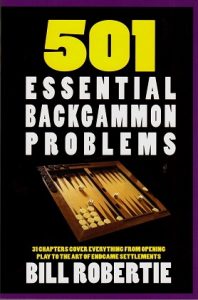 In 31 quiz-format chapters, Bill Robertie offers up 501 highly relevant backgammon problems that encompass most of the frequently-recurring situations that arise in competitive play. The first 12 chapters are best read in sequence, establishing the major patterns and essential elements of backgammon, but thereafter you won’t be able to resist navigating at will among the 19 other sharply-defined topics, targeting the ones you struggle with most: “Action Doubles,” “Breaking Anchor,” and “Post-Ace-Point Games” among them.
In 31 quiz-format chapters, Bill Robertie offers up 501 highly relevant backgammon problems that encompass most of the frequently-recurring situations that arise in competitive play. The first 12 chapters are best read in sequence, establishing the major patterns and essential elements of backgammon, but thereafter you won’t be able to resist navigating at will among the 19 other sharply-defined topics, targeting the ones you struggle with most: “Action Doubles,” “Breaking Anchor,” and “Post-Ace-Point Games” among them.
Backgammon: From Basics to Badass (2015) - Marc Brockmann Olsen
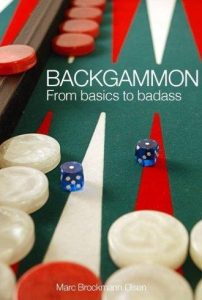 While this weighty text indeed covers the basic rules and fundamental ideas of the game, it is hardly intended for the beginning player. Rather, this almost encyclopedic overview of backgammon concepts, techniques, and strategies is perfect for the player who has already engaged in substantial competitive match or money play but has yet to acquire the terminology and working tools required for Open-level (expert) play. While it can be read sequentially, cover to cover, in an intense immersion in backgammon theory, it will be difficult for most players to absorb, retain, and apply such a flood of knowledge all at once. A better approach might be to read one, or a few, sections at a time and then spend time focusing on these few particular aspects of the game while playing practice matches online or against software programs like eXtreme Gammon.
While this weighty text indeed covers the basic rules and fundamental ideas of the game, it is hardly intended for the beginning player. Rather, this almost encyclopedic overview of backgammon concepts, techniques, and strategies is perfect for the player who has already engaged in substantial competitive match or money play but has yet to acquire the terminology and working tools required for Open-level (expert) play. While it can be read sequentially, cover to cover, in an intense immersion in backgammon theory, it will be difficult for most players to absorb, retain, and apply such a flood of knowledge all at once. A better approach might be to read one, or a few, sections at a time and then spend time focusing on these few particular aspects of the game while playing practice matches online or against software programs like eXtreme Gammon.
Opening Concepts (2017) - Michihito Kageyama & Roland Herrera
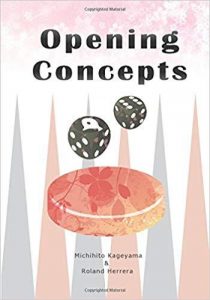 Studying the opening phase of the game is one of the best investments of study time you can make: every game has an opening, and if you don’t play these early exchanges as well as your opponent, you’ll find yourself struggling in more than your share of games. Michihito Kageyama’s Opening Concepts has been almost euphorically greeted by the backgammon community — at least among players who had not already achieved expertise in this area. Michy builds our understanding through a series of “proverbs” that express generally desirable actions or guide play in specific situations. Phrases like “Break the Mountain” (for “unstack”) and “Double Tiger” (hit twice in home board, leaving two blots) have already entered the popular backgammon vocabulary. (The book is less effective in helping the player weigh competing “proverbs” when they point us in different directions). The lessons are enlivened by Roland Herrera’s fanciful illustrations of “Nono,” which you’ll find delightful or annoying depending on your tolerance for puns and cute-factor. But if Nono is your idea of a deal-breaker you may need to lighten up.
Studying the opening phase of the game is one of the best investments of study time you can make: every game has an opening, and if you don’t play these early exchanges as well as your opponent, you’ll find yourself struggling in more than your share of games. Michihito Kageyama’s Opening Concepts has been almost euphorically greeted by the backgammon community — at least among players who had not already achieved expertise in this area. Michy builds our understanding through a series of “proverbs” that express generally desirable actions or guide play in specific situations. Phrases like “Break the Mountain” (for “unstack”) and “Double Tiger” (hit twice in home board, leaving two blots) have already entered the popular backgammon vocabulary. (The book is less effective in helping the player weigh competing “proverbs” when they point us in different directions). The lessons are enlivened by Roland Herrera’s fanciful illustrations of “Nono,” which you’ll find delightful or annoying depending on your tolerance for puns and cute-factor. But if Nono is your idea of a deal-breaker you may need to lighten up.
Endgame Technique (2019) - Michihito Kageyama & Roland Herrera
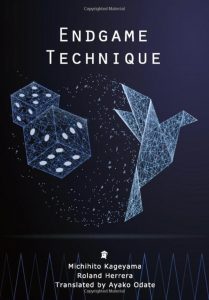 Michy Kageyama’s followup to his popular Opening Concepts (1917) fills a conspicuous gap in the backgammon literature. Nowhere else have we seen the routine mechanics of late-game checker play scenarios treated in such meticulous detail — which is a little surprising, given how frequently these situations arise. How do you bear off checkers against an ace-point anchor in order to minimize your chances of leaving a blot? How about a deuce-point anchor? How do you bear in checkers to your home-board and then bear them off most efficiently in a simple race? How do you decide when to break your deep anchor, or split your checkers, when you are desperate to induce a game-saving blot against your opponent’s bear-off? Even expert players who think they know all about these topics will discover surprising and subtle techniques to help squeeze every bit of equity out of the final phases of the game.
Michy Kageyama’s followup to his popular Opening Concepts (1917) fills a conspicuous gap in the backgammon literature. Nowhere else have we seen the routine mechanics of late-game checker play scenarios treated in such meticulous detail — which is a little surprising, given how frequently these situations arise. How do you bear off checkers against an ace-point anchor in order to minimize your chances of leaving a blot? How about a deuce-point anchor? How do you bear in checkers to your home-board and then bear them off most efficiently in a simple race? How do you decide when to break your deep anchor, or split your checkers, when you are desperate to induce a game-saving blot against your opponent’s bear-off? Even expert players who think they know all about these topics will discover surprising and subtle techniques to help squeeze every bit of equity out of the final phases of the game.
How To Play the Opening in Backgammon, Part 1 (2020) - Bill Robertie
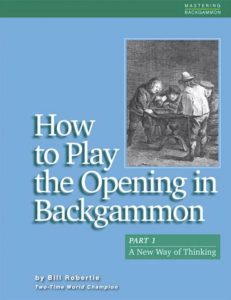
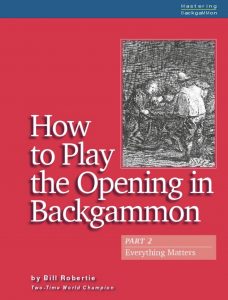 The opening is arguably the most important phase to master: every game’s got one. Here at last is a thorough treatment of the opening few exchanges in backgammon. While you may already know the best opening plays, Robertie offers a fresh take on how the various options compare in terms of assets and liabilities, while also providing intriguing historical notes on how professional practice evolved over the past century. And rather than pursuing the usual “rules & exceptions” approach to the opening replies, Robertie conveys the logic behind the most common default plays while also finding the common elements in smaller subsets of more difficult positions. Parts 1 & 2 are out, and the third is eagerly awaited.
The opening is arguably the most important phase to master: every game’s got one. Here at last is a thorough treatment of the opening few exchanges in backgammon. While you may already know the best opening plays, Robertie offers a fresh take on how the various options compare in terms of assets and liabilities, while also providing intriguing historical notes on how professional practice evolved over the past century. And rather than pursuing the usual “rules & exceptions” approach to the opening replies, Robertie conveys the logic behind the most common default plays while also finding the common elements in smaller subsets of more difficult positions. Parts 1 & 2 are out, and the third is eagerly awaited.
Color Me backgammon (2020) - Phyllis Shapiro (et al.)
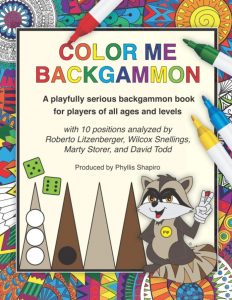 “A playfully serious backgammon books for players of all ages and levels,” this fanciful coloring book offers 10 positions analyzed by respected BG practitioners (Roberto Litzenberger, Wilcox Snellings, Dvid Todd, and our very own Marty Storer!). A stealth tactic for drawing people into the game (come for the coloring, stay for the analysis), this deceptively simple book introduces professional level concepts (complete with XG rollout data in the solutions) in a playful package (including a talking raccoon named Pip).
“A playfully serious backgammon books for players of all ages and levels,” this fanciful coloring book offers 10 positions analyzed by respected BG practitioners (Roberto Litzenberger, Wilcox Snellings, Dvid Todd, and our very own Marty Storer!). A stealth tactic for drawing people into the game (come for the coloring, stay for the analysis), this deceptively simple book introduces professional level concepts (complete with XG rollout data in the solutions) in a playful package (including a talking raccoon named Pip).
Back Checker Strategy (2021) - Michihito Kageyama & Roland Herrera
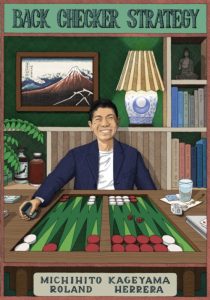 The third in Michy Kageyama’s Backgammon Odyssey series of thematic studies addresses proper handling of checkers straggling in your opponent’s home board. Until you’ve successfully escaped both your back men, decisions about whether to split, or to run, or to give up a precious anchor in order to hit a blot are a nearly constant challenge, and Michy usefully characterizes back checker strategy into five distinct “phases” (though “scenarios” might have been a better term), elucidating useful precepts for handling common choices that arise in each. And as always, Michy employs colorful metaphors (“Butterfly Anchor,” “Glued Checkers”) to help his proverbial advice lodge in your memory.
The third in Michy Kageyama’s Backgammon Odyssey series of thematic studies addresses proper handling of checkers straggling in your opponent’s home board. Until you’ve successfully escaped both your back men, decisions about whether to split, or to run, or to give up a precious anchor in order to hit a blot are a nearly constant challenge, and Michy usefully characterizes back checker strategy into five distinct “phases” (though “scenarios” might have been a better term), elucidating useful precepts for handling common choices that arise in each. And as always, Michy employs colorful metaphors (“Butterfly Anchor,” “Glued Checkers”) to help his proverbial advice lodge in your memory.
Backgammon Master Class (2023) - Marc Olsen & Masayuki Mochizuki
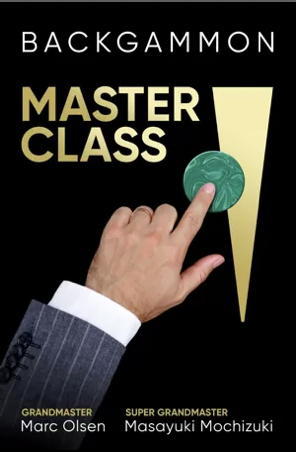 This book encapsulates the wisdom delivered by the authors in a four-part series of lectures at the 2021 UBC event in Marbella, Spain. Mochy’s opening section on “Strategic Visualization” and Marc’s follow-up on “Game Plan Dynamics” provide an accessible, immediately useful guide to understanding the fundamental backgammon game plans and acting upon them, a skill that provides an essential bridge from the Intermediate to the Advanced level of play. Having studied these sections, even advanced players will approach games with a new clarity of purpose that leads to more deliberate, accurate checker play. Mochy’s intervening section on “Backgame Strategy” provides a detailed anatomy of the various backgame configurations and how to get the most out of them. The final section, “Cube Action in Undefined Positions” by Marc, addresses the vast field of mid-game cube decisions that cannot be addressed by the many reliable reference positions available for well-defined opening blitzes, holding games, and bearoffs. The “Olsen Point System” evaluates such a position by assessing available threats and viable game plans in a simple formula. This section requires a far more advanced level of expertise to digest and apply effectively, as it relies upon a firm mastery of game-plan evaluations to begin with. As a result, these master classes taken in sequence should be highly effective in driving any reader’s PR in the right direction. The book is available in a handsome hardback and a more economical paperback version.
This book encapsulates the wisdom delivered by the authors in a four-part series of lectures at the 2021 UBC event in Marbella, Spain. Mochy’s opening section on “Strategic Visualization” and Marc’s follow-up on “Game Plan Dynamics” provide an accessible, immediately useful guide to understanding the fundamental backgammon game plans and acting upon them, a skill that provides an essential bridge from the Intermediate to the Advanced level of play. Having studied these sections, even advanced players will approach games with a new clarity of purpose that leads to more deliberate, accurate checker play. Mochy’s intervening section on “Backgame Strategy” provides a detailed anatomy of the various backgame configurations and how to get the most out of them. The final section, “Cube Action in Undefined Positions” by Marc, addresses the vast field of mid-game cube decisions that cannot be addressed by the many reliable reference positions available for well-defined opening blitzes, holding games, and bearoffs. The “Olsen Point System” evaluates such a position by assessing available threats and viable game plans in a simple formula. This section requires a far more advanced level of expertise to digest and apply effectively, as it relies upon a firm mastery of game-plan evaluations to begin with. As a result, these master classes taken in sequence should be highly effective in driving any reader’s PR in the right direction. The book is available in a handsome hardback and a more economical paperback version.
Advanced
New Ideas in Backgammon (1996) - Kit Woolsey & Hal Heinrich
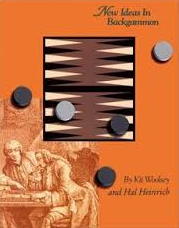 This very challenging problem book gathers 104 serious errors by world-class players in live tournament settings. All are checker-play problems, normalized for money play (so match score doesn’t come into it). It is the first backgammon text to make use of a neural net program, Jellyfish, to validate its conclusions, and the introduction provides a nice historical overview of bot capabilities and weaknesses at this early date. With the rollout data included for the top candidate plays, you can score your performance by the severity of your errors and calculate an average performance score for each of the thematic chapters, which point to perennially difficult game situations: “Anchors Aweigh,” “Pay Me Now or Pay Me Later,” “Scrambling Home” etc. And of course it’s Kit Woolsey, so the analysis is predictably lucid and compelling — and particularly thorough as he weighs each plausible candidate move in turn out loud.
This very challenging problem book gathers 104 serious errors by world-class players in live tournament settings. All are checker-play problems, normalized for money play (so match score doesn’t come into it). It is the first backgammon text to make use of a neural net program, Jellyfish, to validate its conclusions, and the introduction provides a nice historical overview of bot capabilities and weaknesses at this early date. With the rollout data included for the top candidate plays, you can score your performance by the severity of your errors and calculate an average performance score for each of the thematic chapters, which point to perennially difficult game situations: “Anchors Aweigh,” “Pay Me Now or Pay Me Later,” “Scrambling Home” etc. And of course it’s Kit Woolsey, so the analysis is predictably lucid and compelling — and particularly thorough as he weighs each plausible candidate move in turn out loud.
Vision Laughs at Counting / Advice to the Dicelorn (1996) - Danny Kleinman
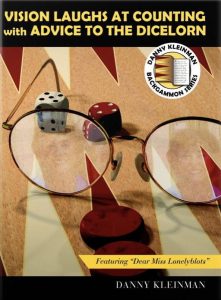 This bountiful collection of Danny Kleinman backgammon musings and analysis from the 1980’s has something for pretty much everyone: vision and counting — and laughs. Kleinman is celebrated as one of the most numerate and mathematical theoreticians of backgammon, but he also delights in describing the social and psychological aspects of the game, often to hilarious effect. (In fact, this book could just as well appear under the “Historical Interest” section below, for the vivid detail with which he captures the way people behaved around a chouette table in the 70’s-80’s period — warts and all.) Kleinman’s highly technical articles are leavened by more immediately practical ‘Dear Abby’-style exchanges with “Miss Lonelyblots.” Kleinman’s books have been reissued in nicely-formatted hardback, spiral, or softback versions, and can also be purchased for iPad viewing via Applebooks.
This bountiful collection of Danny Kleinman backgammon musings and analysis from the 1980’s has something for pretty much everyone: vision and counting — and laughs. Kleinman is celebrated as one of the most numerate and mathematical theoreticians of backgammon, but he also delights in describing the social and psychological aspects of the game, often to hilarious effect. (In fact, this book could just as well appear under the “Historical Interest” section below, for the vivid detail with which he captures the way people behaved around a chouette table in the 70’s-80’s period — warts and all.) Kleinman’s highly technical articles are leavened by more immediately practical ‘Dear Abby’-style exchanges with “Miss Lonelyblots.” Kleinman’s books have been reissued in nicely-formatted hardback, spiral, or softback versions, and can also be purchased for iPad viewing via Applebooks.
Modern Backgammon (2001) - Bill Robertie
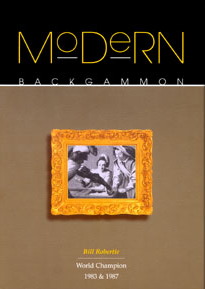 Modern Backgammon might seem like a generic title, but it’s not. At the time of writing, the backgammon world was getting roundly schooled by upstart neural net computer programs that were suddenly beating the best human players — but the ‘bots weren’t telling how. What was needed was a master theorist who could study robotic play and translate their often baffling choices into human principles. Bill Robertie does just that, offering four new conceptual arrows for our quiver: Efficiency, Connectivity, Non-Commitment, and Robustness. In a perverse twist, a later, even stronger program (eXtreme Gammon – ‘XG’) would overturn some of these earlier bot decisions — particularly in the chapter on “Robustness,” but these four concepts are here to stay.
Modern Backgammon might seem like a generic title, but it’s not. At the time of writing, the backgammon world was getting roundly schooled by upstart neural net computer programs that were suddenly beating the best human players — but the ‘bots weren’t telling how. What was needed was a master theorist who could study robotic play and translate their often baffling choices into human principles. Bill Robertie does just that, offering four new conceptual arrows for our quiver: Efficiency, Connectivity, Non-Commitment, and Robustness. In a perverse twist, a later, even stronger program (eXtreme Gammon – ‘XG’) would overturn some of these earlier bot decisions — particularly in the chapter on “Robustness,” but these four concepts are here to stay.
The Backgammon Encyclopedia Vols. 1 (2002) & 2 (2017) - Kit Woolsey
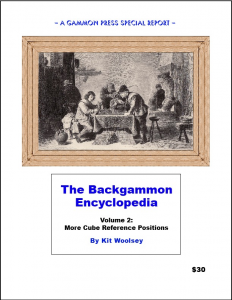 It might seem that stronger players must be mathematical geniuses, or just have a powerful but mysterious intuition about the proper time to double, and when to pass . . . but mostly they just know lots and lots of reference positions. These are sharply defined, illustrative positions that represent a common type of situation you encounter over the board. By comparing the position in front of them to a known reference position they’ve studied, experts can make confident and accurate decisions. In these two volumes of “Cube Reference Positions,” Kit Woolsey lays out a host of powerful reference positions guiding cube action in 19 categories covering all sorts of blitzes, holding games, races, back games, and touchy situations where you have a checker or two on the bar. Unfortunately, the highly sought-after Volume 1 is out of print and very hard to find.
It might seem that stronger players must be mathematical geniuses, or just have a powerful but mysterious intuition about the proper time to double, and when to pass . . . but mostly they just know lots and lots of reference positions. These are sharply defined, illustrative positions that represent a common type of situation you encounter over the board. By comparing the position in front of them to a known reference position they’ve studied, experts can make confident and accurate decisions. In these two volumes of “Cube Reference Positions,” Kit Woolsey lays out a host of powerful reference positions guiding cube action in 19 categories covering all sorts of blitzes, holding games, races, back games, and touchy situations where you have a checker or two on the bar. Unfortunately, the highly sought-after Volume 1 is out of print and very hard to find.
Classic Backgammon Revisited, 2nd edition (2005) - Jeremy Bagai
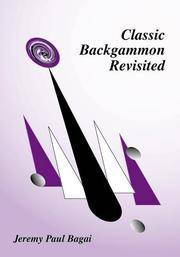 With the advent of strong backgammon-playing programs in the late 1990’s, it became possible to look back at the entire corpus of backgammon writing in fact-checking mode. Jeremy Bagai rose to the task, running rollout analysis on all the positions presented in five seminal texts: Jacoby & Crawford’s The Backgammon Book (1970), Dwek’s Backgammon for Profit, (1975), Magriel’s Backgammon (1976), Cooke’s Paradoxes and Probabilities (1978), and Robertie’s Advanced Backgammon (2nd edition, 1991). Far from simply second-guessing the original authors with the help of a tool they lacked, Bagai proves himself worthy to be in their company with subtle analyses of how, and perhaps why, 120 of their problem solutions now appear to have been substantially incorrect.
With the advent of strong backgammon-playing programs in the late 1990’s, it became possible to look back at the entire corpus of backgammon writing in fact-checking mode. Jeremy Bagai rose to the task, running rollout analysis on all the positions presented in five seminal texts: Jacoby & Crawford’s The Backgammon Book (1970), Dwek’s Backgammon for Profit, (1975), Magriel’s Backgammon (1976), Cooke’s Paradoxes and Probabilities (1978), and Robertie’s Advanced Backgammon (2nd edition, 1991). Far from simply second-guessing the original authors with the help of a tool they lacked, Bagai proves himself worthy to be in their company with subtle analyses of how, and perhaps why, 120 of their problem solutions now appear to have been substantially incorrect.
In making this monumental effort, Bagai has also helped to rejuvenate these five excellent books, providing a means to study and enjoy them with confidence.
Backgammon Praxis, Vols. One & Two (2005) - Marty Storer *Now Available in Print*
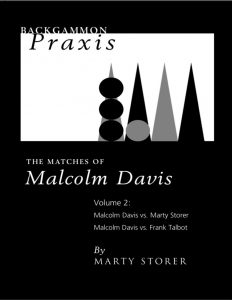 In this monumental study of three matches featuring Malcolm Davis in contests against Ed O’Laughlin, author Marty Storer, and Frank Talbot, Storer produced what is widely regarded as the most substantive and sophisticated match analysis book in the literature. Marty engaged the participants to talk through each game, so reading it feels like sitting at the table with them, as they re-trace their thought processes for the tougher plays and grapple with those decisions that Snowie took issue with in extended rollouts. Storer includes diagrams of alternative plays, so that options can be seen rather than merely visualized, and ends each game with a brief enumeration of “lessons” to be taken away and applied to our own matches. With an original press run of Praxis of only 600 copies, the books were unavailable for years, but have been newly re-issued in 2022 and are now available for sale on Amazon: Volume 1 / Volume 2.
In this monumental study of three matches featuring Malcolm Davis in contests against Ed O’Laughlin, author Marty Storer, and Frank Talbot, Storer produced what is widely regarded as the most substantive and sophisticated match analysis book in the literature. Marty engaged the participants to talk through each game, so reading it feels like sitting at the table with them, as they re-trace their thought processes for the tougher plays and grapple with those decisions that Snowie took issue with in extended rollouts. Storer includes diagrams of alternative plays, so that options can be seen rather than merely visualized, and ends each game with a brief enumeration of “lessons” to be taken away and applied to our own matches. With an original press run of Praxis of only 600 copies, the books were unavailable for years, but have been newly re-issued in 2022 and are now available for sale on Amazon: Volume 1 / Volume 2.
Backgammon Openings: Book A (2007) - Nack Ballard & Paul Weaver
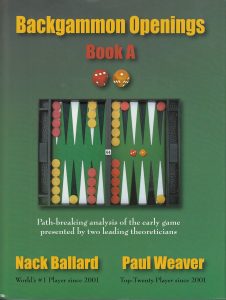 This meticulous work of backgammon scholarship was made possible by the advent of strong computer-rollout programs and the dogged brilliance of both authors, who devote this entire volume to the proper playing of 3-1 in the first three exchanges of a backgammon game. The virtues and risks of various hitting, pointing and slotting options are weighed in each position, and similar positions are juxtaposed to help the reader form a deep understanding of the relative weight of different factors. While further volumes had been planned (and eagerly anticipated), there is, alas, no Book B. However, mastery of the dynamics of early 3-1 plays may translate into superior early play in general.
This meticulous work of backgammon scholarship was made possible by the advent of strong computer-rollout programs and the dogged brilliance of both authors, who devote this entire volume to the proper playing of 3-1 in the first three exchanges of a backgammon game. The virtues and risks of various hitting, pointing and slotting options are weighed in each position, and similar positions are juxtaposed to help the reader form a deep understanding of the relative weight of different factors. While further volumes had been planned (and eagerly anticipated), there is, alas, no Book B. However, mastery of the dynamics of early 3-1 plays may translate into superior early play in general.
What's Your Game Plan? (2011) - Mary Hickey & Marty Storer
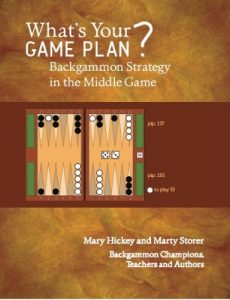 Most backgammon books take a thematic approach to organizing their lessons and example positions. After all, the point isn’t to learn what to do in a specific, unique position — it’s to master principles of play that we can apply to frequently arising “kinds” of situations, right? Well, yes, but somehow backgammon doesn’t always cooperate, serving up problems that yield placidly to general principles. In What’s Your Game Plan? Hickey and Storer serve up 122 gnarly checker-play problems arising from the difficult middle-game phase, and walk you through the thought processes that world-class players use to arrive at the right answer. Many of the problems arise from crucial inflection points in a game, when rival plays lead to substantially different approaches to winning — hence the title. In addition to all the analytical practice, readers will come away from the book with an invaluable over-arching habit: actively thinking about and choosing among the viable game plans available to you, rather than playing backgammon as a series of disconnected quiz problems.
Most backgammon books take a thematic approach to organizing their lessons and example positions. After all, the point isn’t to learn what to do in a specific, unique position — it’s to master principles of play that we can apply to frequently arising “kinds” of situations, right? Well, yes, but somehow backgammon doesn’t always cooperate, serving up problems that yield placidly to general principles. In What’s Your Game Plan? Hickey and Storer serve up 122 gnarly checker-play problems arising from the difficult middle-game phase, and walk you through the thought processes that world-class players use to arrive at the right answer. Many of the problems arise from crucial inflection points in a game, when rival plays lead to substantially different approaches to winning — hence the title. In addition to all the analytical practice, readers will come away from the book with an invaluable over-arching habit: actively thinking about and choosing among the viable game plans available to you, rather than playing backgammon as a series of disconnected quiz problems.
Backgammon: Pure Strategy (2017) - Marc B. Olsen
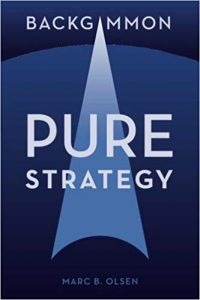 This provocative modern book tends to divide readers quite sharply. Some disdain it (in part because the English is poorly rendered), while many others swear by it. Olsen claims to offer a bold new method of thinking about backgammon, based on the neural network AI technique underlying strong backgammon programs like XG. If his method is as powerful as he says it is, and if many readers can internalize it, the book may enhance our evolving understanding of the game. The jury is out, and will be for a good while. So approach this text with caution, but ignore it at your peril.
This provocative modern book tends to divide readers quite sharply. Some disdain it (in part because the English is poorly rendered), while many others swear by it. Olsen claims to offer a bold new method of thinking about backgammon, based on the neural network AI technique underlying strong backgammon programs like XG. If his method is as powerful as he says it is, and if many readers can internalize it, the book may enhance our evolving understanding of the game. The jury is out, and will be for a good while. So approach this text with caution, but ignore it at your peril.
Cube Like a Boss (2019) - Marc B. Olsen
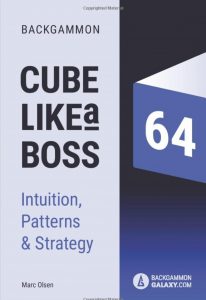 Backgammon as been overdue for a book devoted to doubling, perhaps for good reason. The many considerations that go into cube decisions are complicated by the wide variety of situations they arise in, so an expert cube handler needs to study and acquire a wide variety of reference positions and tools for various scenarios: early blitz, prime vs prime, holding games, post-hit re-cubes are just a few. Cube Like a Boss methodically covers 14 of these distinctive scenarios. It’s not a book that’s easy to absorb in one cover-to-cover reading, so students of the game might do best concentrating on one section at a time — perhaps going to the appropriate chapter when you discover over the board that you really don’t know how to think about doubling in certain situations. If you can integrate Olsen’s guidance in your play, you will indeed become a boss cube handler.
Backgammon as been overdue for a book devoted to doubling, perhaps for good reason. The many considerations that go into cube decisions are complicated by the wide variety of situations they arise in, so an expert cube handler needs to study and acquire a wide variety of reference positions and tools for various scenarios: early blitz, prime vs prime, holding games, post-hit re-cubes are just a few. Cube Like a Boss methodically covers 14 of these distinctive scenarios. It’s not a book that’s easy to absorb in one cover-to-cover reading, so students of the game might do best concentrating on one section at a time — perhaps going to the appropriate chapter when you discover over the board that you really don’t know how to think about doubling in certain situations. If you can integrate Olsen’s guidance in your play, you will indeed become a boss cube handler.
The Backgammon Chronicles (2020) - Robert Wachtel
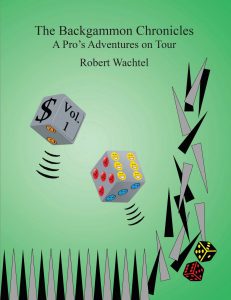
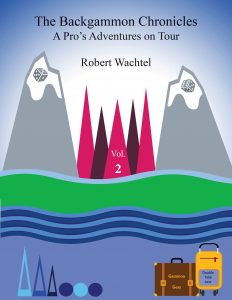 In this richly-illustrated two-volume set, Bob Wachtel captures the contemporary backgammon scene of the past decade our so by relating his wide experience of the game in a dazzling variety of settings and situations, introducing you to many prominent and colorful players of our times. While the focus is on recent history, Bob draws on his earliest days in the game in the late 1970’s as well, providing a useful account of how the traditions, practices, and social conventions surrounding the game have evolved over time — especially due to the advent of the ‘bots. The mode of these volumes is anecdotal and philosophical, so practical backgammon-playing wisdom is only secondary, but the reader will come away with valuable perspectives on how to behave and thrive in the world of competitive backgammon.
In this richly-illustrated two-volume set, Bob Wachtel captures the contemporary backgammon scene of the past decade our so by relating his wide experience of the game in a dazzling variety of settings and situations, introducing you to many prominent and colorful players of our times. While the focus is on recent history, Bob draws on his earliest days in the game in the late 1970’s as well, providing a useful account of how the traditions, practices, and social conventions surrounding the game have evolved over time — especially due to the advent of the ‘bots. The mode of these volumes is anecdotal and philosophical, so practical backgammon-playing wisdom is only secondary, but the reader will come away with valuable perspectives on how to behave and thrive in the world of competitive backgammon.
The Zizka Method (2021) - Zdenek Zizka
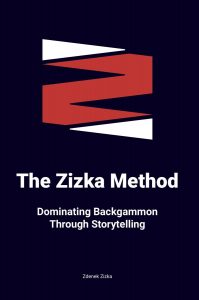 A great deal of backgammon wisdom takes the form of general principles, rules of thumb, or mathematical formulas for quantifying racing chances or solving cube decisions. But when none of your tools point confidently to a best play, what then? Zdenek Zizka’s “storytelling” method is an approach to reaching a conclusion by projecting “what rates to happen” in the ensuing exchange or two, often by breaking down your opponent’s immediate reply into subsets of useful or useless numbers. The informal tone of the writing won’t please everyone (and it’s riddled with typos), but it does capture the rough, over-the-board thought process the author is modeling. Zizka credits his youthful and meteoric rise in backgammon to his friend and teacher Mike “Falafel” Natanzon, who never published his methods, so we may be gaining some of them here.
A great deal of backgammon wisdom takes the form of general principles, rules of thumb, or mathematical formulas for quantifying racing chances or solving cube decisions. But when none of your tools point confidently to a best play, what then? Zdenek Zizka’s “storytelling” method is an approach to reaching a conclusion by projecting “what rates to happen” in the ensuing exchange or two, often by breaking down your opponent’s immediate reply into subsets of useful or useless numbers. The informal tone of the writing won’t please everyone (and it’s riddled with typos), but it does capture the rough, over-the-board thought process the author is modeling. Zizka credits his youthful and meteoric rise in backgammon to his friend and teacher Mike “Falafel” Natanzon, who never published his methods, so we may be gaining some of them here.
Holding Game Guru (2021) - Jacob "Stick" Rice
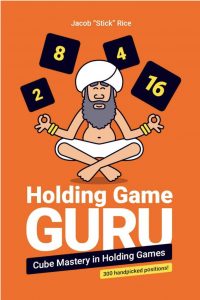 Studying holding game cube action is one of the best investments of time you can make as a competitive player. They just come up so regularly that you’re going to benefit over and over again for even small improvements in play. In this first book-length offering from respected author of the BackgammonVillage “Sticks and Stones” series of articles, Jacob “Stick” Rice shares his arsenal of four Rules and ten Reference Positions and then goes on to analyze a whopping 300 non-obvious holding game cube positions to thoroughly illustrate the considerations that lead to proper play. The positions don’t appear to be grouped or ordered in any particular way (there is a chapter division between the first and second halves of 150 positions, but no suggestion why), perhaps intended to emulate actual play, where every variety of holding game will appear at random. Rice’s analysis is concise and engagingly colloquial, modeling an approach to reasoning over the board that readers can hope to emulate.
Studying holding game cube action is one of the best investments of time you can make as a competitive player. They just come up so regularly that you’re going to benefit over and over again for even small improvements in play. In this first book-length offering from respected author of the BackgammonVillage “Sticks and Stones” series of articles, Jacob “Stick” Rice shares his arsenal of four Rules and ten Reference Positions and then goes on to analyze a whopping 300 non-obvious holding game cube positions to thoroughly illustrate the considerations that lead to proper play. The positions don’t appear to be grouped or ordered in any particular way (there is a chapter division between the first and second halves of 150 positions, but no suggestion why), perhaps intended to emulate actual play, where every variety of holding game will appear at random. Rice’s analysis is concise and engagingly colloquial, modeling an approach to reasoning over the board that readers can hope to emulate.
The Theory of Backgammon (2021) - Dirk Schiemann
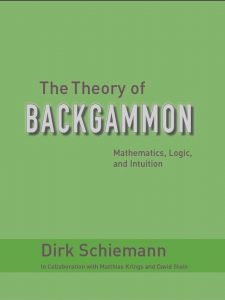 The “theory” laid out in this weighty tome isn’t for the serious beginner looking to start from the ground up with the basics. Rather, Schiemann lays out the mathematical considerations that govern optimal play in match and money play situations before pursuing a series of deep dives into a whole slate of specialized situations that bedevil already expert players looking to achieve world-class skills: doubling windows, cube efficiency, checker-play implications of cube ownership, adjusting play against stronger or weaker opponents, etc. Unlike many recent publications in backgammon, this handsome hardback book is professionally designed and typeset, reflecting the care Schiemann has taken with his analysis and editing, justifying the high price tag for those committed enough to seriously study its contents.
The “theory” laid out in this weighty tome isn’t for the serious beginner looking to start from the ground up with the basics. Rather, Schiemann lays out the mathematical considerations that govern optimal play in match and money play situations before pursuing a series of deep dives into a whole slate of specialized situations that bedevil already expert players looking to achieve world-class skills: doubling windows, cube efficiency, checker-play implications of cube ownership, adjusting play against stronger or weaker opponents, etc. Unlike many recent publications in backgammon, this handsome hardback book is professionally designed and typeset, reflecting the care Schiemann has taken with his analysis and editing, justifying the high price tag for those committed enough to seriously study its contents.
Backgammon Super Genius Quiz (2022) - James Vogl
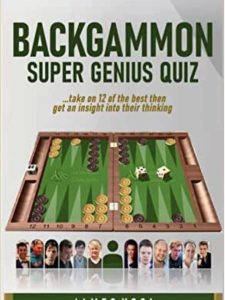 James Vogl hit upon a brilliant strategy for a book: assemble a slate of a dozen world-respected backgammon greats (including former Harvard Square BG denizen David Wells!) and have them vie for a $5000 prize by quizzing them on 100 super-tough positions he had gotten wrong over the board. Then present the same 10-section quiz to readers accompanied by pithy, focused commentary from the contestants and summaries of what can be learned from each topical set of 10 problems. The resulting book is incredibly engaging, as the reader is invited to self-score and compare their results to the running totals of the “super geniuses.” The book is full of memorable, useful “rules of thumb” and approaches to problem solving the reader can readily deploy over the board. While the graphics of the book have been lamented in some quarters (board diagrams are stretched screen shots of XG windows, making it hard to read the equity figures), the practical content and entertainment value of the book are easily worth the price of this softcover book.
James Vogl hit upon a brilliant strategy for a book: assemble a slate of a dozen world-respected backgammon greats (including former Harvard Square BG denizen David Wells!) and have them vie for a $5000 prize by quizzing them on 100 super-tough positions he had gotten wrong over the board. Then present the same 10-section quiz to readers accompanied by pithy, focused commentary from the contestants and summaries of what can be learned from each topical set of 10 problems. The resulting book is incredibly engaging, as the reader is invited to self-score and compare their results to the running totals of the “super geniuses.” The book is full of memorable, useful “rules of thumb” and approaches to problem solving the reader can readily deploy over the board. While the graphics of the book have been lamented in some quarters (board diagrams are stretched screen shots of XG windows, making it hard to read the equity figures), the practical content and entertainment value of the book are easily worth the price of this softcover book.
Of Historical Interest
Many backgammon books retain their interest over time despite being superseded by newer books that have proven more authoritative. It can be fascinating to note how professional practice has changed over time, and so long as you bring a critical mind to your reading, you may deepen your grasp of the game by understanding how it was played in previous eras. Most of the books in this section, though, are recommended more for the window they open on the backgammon attitudes, traditions, and styles of earlier times.
Vanity Fair's Backgammon To Win (1930) - Georges Mabardi
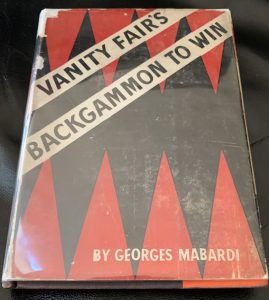 1930-31 were boom years for backgammon’s first American heyday, with several very charming books being published to capitalize on the craze. Of particular interest in these books are references to two recent innovations of the day: the chouette and “the double.” Georges Mabardi’s entries on doubling are intriguing because (a) he makes no reference to a doubling “cube” or “block” or even the little bakelite matches that were sometimes used to keep track of a game’s value; and (b) his dismissive attitude toward doubling itself displays what must have been a popular failure to grasp the “25% rule” governing cube action. “. . . if two absolutely perfect players engaged in a match, there would never be an accepted double . . . The author’s chief objection to the double is precisely this — its only raison d’être is the incompetent play of those who use it. For there can be no final difference of opinion on the value of position; . . . two expert players will never disagree.” Many other passages make for amusing reader, particularly a chapter in etiquette in which he laments the annoying behavior of the chortler, the grouser, and the coaxer among others. This book was re-issued in 1974 to capitalize on American backgammon’s second wave — but sadly, they for some reason omitted the delightful art deco illustrations of martini glasses, cigarettes, and other stylish items that accompanied the board diagrams. Pictured here is the original hardback with a rare dust jacket intact.
1930-31 were boom years for backgammon’s first American heyday, with several very charming books being published to capitalize on the craze. Of particular interest in these books are references to two recent innovations of the day: the chouette and “the double.” Georges Mabardi’s entries on doubling are intriguing because (a) he makes no reference to a doubling “cube” or “block” or even the little bakelite matches that were sometimes used to keep track of a game’s value; and (b) his dismissive attitude toward doubling itself displays what must have been a popular failure to grasp the “25% rule” governing cube action. “. . . if two absolutely perfect players engaged in a match, there would never be an accepted double . . . The author’s chief objection to the double is precisely this — its only raison d’être is the incompetent play of those who use it. For there can be no final difference of opinion on the value of position; . . . two expert players will never disagree.” Many other passages make for amusing reader, particularly a chapter in etiquette in which he laments the annoying behavior of the chortler, the grouser, and the coaxer among others. This book was re-issued in 1974 to capitalize on American backgammon’s second wave — but sadly, they for some reason omitted the delightful art deco illustrations of martini glasses, cigarettes, and other stylish items that accompanied the board diagrams. Pictured here is the original hardback with a rare dust jacket intact.
Backgammon Games and Strategies (1977) - Nicolaos & Basil Tzannes
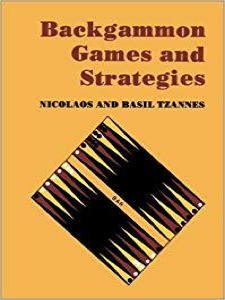 It’s worth remembering that backgammon as we play it is but one variation of the ancient games played on a common backgammon pboard in the Mediterranean and Middle East. The game of Portes is the one that has come to dominate international backgammon competition, but many are still passionate about other games like Plakoto, Moultezim, and Gioul. The Tzannes brothers write, “They are by far much more interesting and exciting than [Portes]. Plakoto is without any doubt the king of backgammon games. Moultezim is a serious game for the fundamentalist, the pure strategist, the complete backgammon player.” If you hope to earn the affection of locals in cafes when traveling in Greece, learning how to play these versions of backgammon would be the best way to start.
It’s worth remembering that backgammon as we play it is but one variation of the ancient games played on a common backgammon pboard in the Mediterranean and Middle East. The game of Portes is the one that has come to dominate international backgammon competition, but many are still passionate about other games like Plakoto, Moultezim, and Gioul. The Tzannes brothers write, “They are by far much more interesting and exciting than [Portes]. Plakoto is without any doubt the king of backgammon games. Moultezim is a serious game for the fundamentalist, the pure strategist, the complete backgammon player.” If you hope to earn the affection of locals in cafes when traveling in Greece, learning how to play these versions of backgammon would be the best way to start.
Backgammon - The Cruelest Game (1974) - Barclay Cooke & Jon Bradshaw
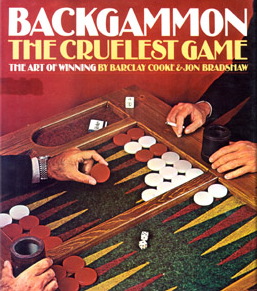 This is one of the great backgammon books of the 1970’s, and its aesthetic qualities will do more to inspire a newish player to embrace backgammon than many “stronger” introductory texts written in the modern neural net era. The writing is eloquent, the diagrams elegant, the typeface and graphics gorgeous. Each chapter opens with a relevant quotation from Clausewitz on war. But there is no getting around the manifest backwardness of much of the advice. A 5-3 opening roll should be played 13/10 13/8 because “At this point in the game the 3 point is almost irrelevant.” Still, the book captures the energy and thrill of backgammon competition, and the sections on settlements (oddly absent from most modern treatises on the game), chouettes, and psychology are always interesting to read, as are the three “great games” presented in the final chapter, for what they preserve about backgammon as played before games were commonly transcribed. In total, this remains a fine introduction to competitive backgammon — so long as it is promptly followed up with more current materials.
This is one of the great backgammon books of the 1970’s, and its aesthetic qualities will do more to inspire a newish player to embrace backgammon than many “stronger” introductory texts written in the modern neural net era. The writing is eloquent, the diagrams elegant, the typeface and graphics gorgeous. Each chapter opens with a relevant quotation from Clausewitz on war. But there is no getting around the manifest backwardness of much of the advice. A 5-3 opening roll should be played 13/10 13/8 because “At this point in the game the 3 point is almost irrelevant.” Still, the book captures the energy and thrill of backgammon competition, and the sections on settlements (oddly absent from most modern treatises on the game), chouettes, and psychology are always interesting to read, as are the three “great games” presented in the final chapter, for what they preserve about backgammon as played before games were commonly transcribed. In total, this remains a fine introduction to competitive backgammon — so long as it is promptly followed up with more current materials.
Backgammon for Blood! (1974) - Bruce Becker
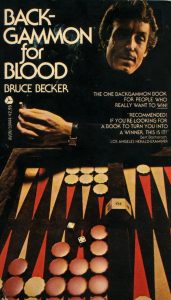 Backgammon for Blood! is possibly the most dangerous book ever written about the game. It’s not just that Becker’s suggestions are wrong-headed (Walter Trice memorably commented “Becker’s map of the world is missing a couple of continents.”) — but that he writes with such swaggering certainty that he’s likely to bend impressionable readers to his will. What to make of a man who eschews an open 65 “Lover’s Leap” as “dull and plodding,” preferring to play two down from the midpoint? The book is a pure study in macho money-game attitude, and reads best in a Schwarzenegger voice. Becker on the Jacoby Rule: “. . . all it does is coddle the lesser player; I don’t think he should stay out late at night playing backgammon if he needs that kind of protection.” This is also a book best purchased in paperback — the cover is priceless, even if it omits the exclamation point.
Backgammon for Blood! is possibly the most dangerous book ever written about the game. It’s not just that Becker’s suggestions are wrong-headed (Walter Trice memorably commented “Becker’s map of the world is missing a couple of continents.”) — but that he writes with such swaggering certainty that he’s likely to bend impressionable readers to his will. What to make of a man who eschews an open 65 “Lover’s Leap” as “dull and plodding,” preferring to play two down from the midpoint? The book is a pure study in macho money-game attitude, and reads best in a Schwarzenegger voice. Becker on the Jacoby Rule: “. . . all it does is coddle the lesser player; I don’t think he should stay out late at night playing backgammon if he needs that kind of protection.” This is also a book best purchased in paperback — the cover is priceless, even if it omits the exclamation point.
Playboy's Book of Backgammon (1977) - Lewis Deyong
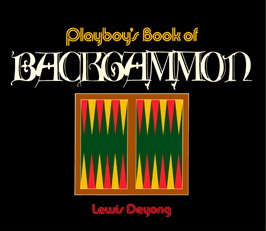 This one is a must-read for anyone interested in the 1960’s – 70’s backgammon scene, as this weighty tome devotes as much space to anecdotal descriptions of backgammon life as to playing techniques. Meet the colorful characters of backgammon’s heyday (including Hugh Hefner, who writes the foreward), and travel the worldwide circuit with this inveterate raconteur: Las Vegas, London, Munich, Athens, Johannesburg, Beirut. Deyong’s idiosyncratic “Seven Pillars of backgammon” haven’t exactly stood the test of time (anyone out there remember “COMBASM”?) — so you can skim the backgammon advice and just enjoy the story-telling. Pictured is the original hardback cover.
This one is a must-read for anyone interested in the 1960’s – 70’s backgammon scene, as this weighty tome devotes as much space to anecdotal descriptions of backgammon life as to playing techniques. Meet the colorful characters of backgammon’s heyday (including Hugh Hefner, who writes the foreward), and travel the worldwide circuit with this inveterate raconteur: Las Vegas, London, Munich, Athens, Johannesburg, Beirut. Deyong’s idiosyncratic “Seven Pillars of backgammon” haven’t exactly stood the test of time (anyone out there remember “COMBASM”?) — so you can skim the backgammon advice and just enjoy the story-telling. Pictured is the original hardback cover.
Paradoxes and Probabilities (1978) - Barclay Cooke
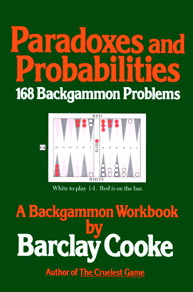 The most infamous of quiz books, Barclay Cooke’s Paradoxes and Probabilities exemplifies the 1970’s “pure style” of play, which emphasized making priming points in order, recirculating deeply-placed checkers at the expense of racing advantage, and too-willingly falling into back games. Rolling out all 168 positions for Classic Backgammon Revisited, Jeremy Bagai discovered that well over half of Cooke’s conclusions are contradicted by modern neural net programs, with a good third of them “badly wrong. ” So bring a curious but critical mind to this one — and keep Bagai’s book close at hand.
The most infamous of quiz books, Barclay Cooke’s Paradoxes and Probabilities exemplifies the 1970’s “pure style” of play, which emphasized making priming points in order, recirculating deeply-placed checkers at the expense of racing advantage, and too-willingly falling into back games. Rolling out all 168 positions for Classic Backgammon Revisited, Jeremy Bagai discovered that well over half of Cooke’s conclusions are contradicted by modern neural net programs, with a good third of them “badly wrong. ” So bring a curious but critical mind to this one — and keep Bagai’s book close at hand.
Championship Backgammon (1980) - Barclay Cooke & Rene Orlean
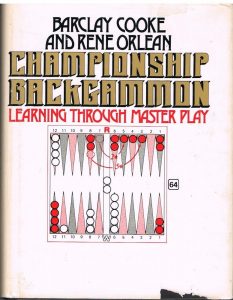 This book provides a fascinating time-capsule view of backgammon as played at the highest levels circa 1973, in a trans-Atlantic throw-down between Barclay Cooke and his son Walter against a British team of Joe Dwek and Philip Martyn, both backgammon writers in their own right. In a somewhat misguided attempt at equalizing the luck factor, the matches were played “duplicate” style, with a single dice roller providing numbers for opposite players on the two boards. Of course, the two games diverge so quickly that the numbers no longer “mean” the same thing for both games (on one board a 66 dances on the bar while on the other it equalizes a losing race). The book perhaps reveals more about Barclay Cooke’s attitude toward competition than it illuminates effective backgammon strategy, but it certainly preserves a fascinating episode in the 1970’s era of the game.
This book provides a fascinating time-capsule view of backgammon as played at the highest levels circa 1973, in a trans-Atlantic throw-down between Barclay Cooke and his son Walter against a British team of Joe Dwek and Philip Martyn, both backgammon writers in their own right. In a somewhat misguided attempt at equalizing the luck factor, the matches were played “duplicate” style, with a single dice roller providing numbers for opposite players on the two boards. Of course, the two games diverge so quickly that the numbers no longer “mean” the same thing for both games (on one board a 66 dances on the bar while on the other it equalizes a losing race). The book perhaps reveals more about Barclay Cooke’s attitude toward competition than it illuminates effective backgammon strategy, but it certainly preserves a fascinating episode in the 1970’s era of the game.
Alpha Backgammon (1980) - Baron Vernon Ball
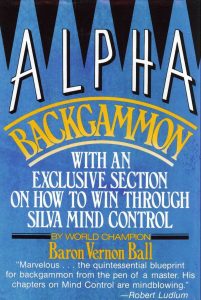 The “luck factor” is a topic of perennial interest to backgammon players, so it’s refreshing to read the advice of a practitioner who decides he’s going to do something about it. If we presume he is in earnest, Baron Vernon Ball must surely rank among the great backgammon philanthropists, showing us how we can improve our dice through “Silva Mind Control” rather than hoarding the technique for personal gain. For instance, in a bear-off with two checkers on one’s own ace-point and an opponent on roll with a checker on the ace- and three- points, Ball encourages us to get busy: “X does not sit idly by and accept as fact that he will lose. X knows that 2-1’s do appear and that he knows how to help make a 2-1 appear more often than probability. X visualizes a 2-1 on his mental screen and concentrates while O is rolling the dice …”(p.186). If this weren’t reason enough to hunt down a copy, Chapter X just might be: Backgammon and Drugs: What Every Player Should Know. “If you have taken more than two or three tokes or smoke more than a single joint and want to play backgammon, find a member of the opposite sex and play for slave time or fun, but don’t expect to perform anywhere near your unstoned abilities.” And don’t even get him started about methaqualone. . .
The “luck factor” is a topic of perennial interest to backgammon players, so it’s refreshing to read the advice of a practitioner who decides he’s going to do something about it. If we presume he is in earnest, Baron Vernon Ball must surely rank among the great backgammon philanthropists, showing us how we can improve our dice through “Silva Mind Control” rather than hoarding the technique for personal gain. For instance, in a bear-off with two checkers on one’s own ace-point and an opponent on roll with a checker on the ace- and three- points, Ball encourages us to get busy: “X does not sit idly by and accept as fact that he will lose. X knows that 2-1’s do appear and that he knows how to help make a 2-1 appear more often than probability. X visualizes a 2-1 on his mental screen and concentrates while O is rolling the dice …”(p.186). If this weren’t reason enough to hunt down a copy, Chapter X just might be: Backgammon and Drugs: What Every Player Should Know. “If you have taken more than two or three tokes or smoke more than a single joint and want to play backgammon, find a member of the opposite sex and play for slave time or fun, but don’t expect to perform anywhere near your unstoned abilities.” And don’t even get him started about methaqualone. . .
Dice, Cubes & Gentlemen (2018) - M. David Sherrill
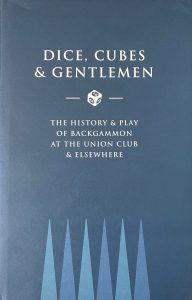 A tome for the committed backgammon historians out there, this limited edition of 500 hardbacks published by the Union Club offers a history of backgammon as played in the world of exclusive New York City gentleman’s clubs. While the copious lists of club champions and award winners may be of interest chiefly to insiders, the book provides entertaining descriptions of the settings and traditions of backgammon play, and encyclopedic illustrated galleries of backgammon books, attractive, illustrations, and facsimiles of early rule sets, as well as a useful historical record of World Champions that we haven’t seen memorialized in book form before. Available while supplies last from Carol Joy Cole’s Backgammon Boutique for a substantial but reasonable $150.
A tome for the committed backgammon historians out there, this limited edition of 500 hardbacks published by the Union Club offers a history of backgammon as played in the world of exclusive New York City gentleman’s clubs. While the copious lists of club champions and award winners may be of interest chiefly to insiders, the book provides entertaining descriptions of the settings and traditions of backgammon play, and encyclopedic illustrated galleries of backgammon books, attractive, illustrations, and facsimiles of early rule sets, as well as a useful historical record of World Champions that we haven’t seen memorialized in book form before. Available while supplies last from Carol Joy Cole’s Backgammon Boutique for a substantial but reasonable $150.
Want More?
For a more comprehensive list of books written on backgammon, complete with publisher’s information, page lengths, and Tables of Contents, visit Tom Keith’s Backgammon Galore! Books page, which reaches back all the way to 1844. Keith’s listings also feature quoted reviews of books that he harvested from online forums and publications.
Also available on the same site, but difficult to find from the homepage, is Art Grater’s remarkable bibliography of backgammon-related books and articles dating back to the 1800’s.
